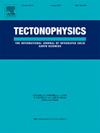页岩气泄漏与断层激活:2021 年中国泸县 MS 6.0 级地震的启示
IF 2.7
3区 地球科学
Q2 GEOCHEMISTRY & GEOPHYSICS
引用次数: 0
摘要
在大型气田地区,人们对页岩气田工业生产引发的地震进行了广泛研究。然而,人们对震后事件对页岩气储层泄漏和断层活化的影响关注有限。2021 年 9 月 16 日在泸州页岩气田发生的泸县 MS 6.0 级地震引起了人们对震后页岩气泄漏的关注。震后在泸州页岩气田地区进行的土壤气体(Rn、CO2、CH4 和 H2)测量和同位素分析(δ13CCO2、δ13CCH4 和 δDCH4)显示,作为页岩气泄漏天然通道的华应山断裂带并未被泸县地震激活,在 2021 年地震后也未出现页岩气进一步泄漏。此外,受地震影响的发震断层也没有破坏页岩气储层,造成页岩气泄漏。这项研究为今后研究该地区页岩气开采和地震活动提供了重要依据。本文章由计算机程序翻译,如有差异,请以英文原文为准。
Shale gas leakage and fault activation: Insight from the 2021 Luxian MS 6.0 earthquake, China
In the region of large gas fields, extensive research has been conducted on earthquakes induced by industrial production in shale gas fields. However, limited attention has been given to the impact of post-earthquake events on shale gas reservoir leakage and fault activation. The Luxian MS 6.0 earthquake, which occurred on 16 September 2021 in the Luzhou shale gas field, has raised concerns about post-earthquake shale gas leakage. Post-earthquake measurements of soil gases (Rn, CO2, CH4, and H2) and isotopic analyses (δ13CCO2, δ13CCH4 and δDCH4) in the Luzhou shale gas field area reveal that the Huayingshan fault zone, a natural pathway for shale gas leakage, was not activated by the Luxian earthquake and did not exhibit any further shale gas leakage after the 2021 earthquake. Furthermore, the seismogenic fault, which was impacted by the earthquake, did not damage the shale gas reservoir, causing shale gas leakage. This study provides an important foundation for future research on shale gas extraction and seismic activity in the region.
求助全文
通过发布文献求助,成功后即可免费获取论文全文。
去求助
来源期刊

Tectonophysics
地学-地球化学与地球物理
CiteScore
4.90
自引率
6.90%
发文量
300
审稿时长
6 months
期刊介绍:
The prime focus of Tectonophysics will be high-impact original research and reviews in the fields of kinematics, structure, composition, and dynamics of the solid arth at all scales. Tectonophysics particularly encourages submission of papers based on the integration of a multitude of geophysical, geological, geochemical, geodynamic, and geotectonic methods
 求助内容:
求助内容: 应助结果提醒方式:
应助结果提醒方式:


